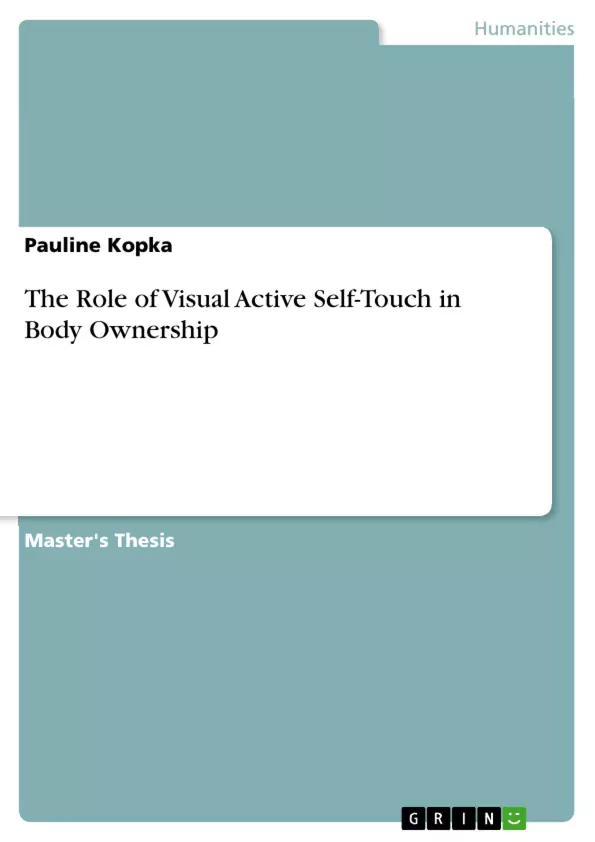The goal of the present study was to investigate how active visual self-touch modulates ownership illusions during the rubber hand illusion (RHI). 23 healthy test subjects participated. A 2x2x2 repeated measures ANOVA was performed, in which self-touch vs. external touch during RHI induction was examined. Additionally, the effect of touching the rubber hand during the RHI vs not touching it was measured, as well as the location of the rubber hand within or outside of peripersonal space (PPS). The measures used were the behavioral measure of the proprioceptive drift (PD) and a 10-item subjective embodiment questionnaire, including the components “ownerhip”, “location” and “agency”.
Based on previous studies and theories regarding self-touch, it was hypothesized that self-touch would positively modulate body ownership. A further postulation was that touching the rubber hand during the RHI, instead of just performing the stroking motion without the touch, would induce a higher sense of embodiment, which could be confirmed. Lastly, it was hypothesized that embodiment would be positively modulated by the rubber hand being inside the PPS of the subject’s own hand.
Inhaltsverzeichnis (Table of Contents)
- Introduction
- Theoretical background
- Body ownership
- The Rubber Hand Illusion
- Psychometrics of body ownership
- The neuropsychological mechanisms of the RHI
- Self-touch
- Self-Touch and body representations
- Self-touch and body-ownership illusions
- State of the art
- Does active visual self-touch induce a greater ownership illusion than external touch?
- Conceptual Hypotheses
- Method
- Experimental Design and operationalization of the independent variables
- Measures of illusory ownership
- RHI Questionnaire
- Proprioceptive drift
- Experimental setup
- Participants
- COVID-19
- Procedure
- Preparation
- Illusion induction
- Empirical hypotheses
- Results
- Data preparation
- Descriptive statistics
- Hypothesis testing
- Testing of hypothesis 1
- Testing of hypothesis 2
- Testing of hypothesis 3
- Explorative analysis
- Discussion
- Summary and discussion of results
- Limitations
- Future research and implications
Zielsetzung und Themenschwerpunkte (Objectives and Key Themes)
The objective of the study was to investigate the influence of active visual self-touch on body ownership illusions during the rubber hand illusion (RHI). The study aimed to identify how different touch conditions, including self-touch, external touch, and the absence of touch, affected participants' sense of embodiment and ownership of the rubber hand. The study also explored the role of peripersonal space (PPS) in modulating embodiment experiences.
- The role of active visual self-touch in modulating body ownership illusions during the RHI.
- The impact of touch conditions (self-touch, external touch, no touch) on embodiment and ownership of the rubber hand.
- The relationship between the location of the rubber hand within or outside PPS and the sense of embodiment.
- The influence of peripersonal space (PPS) on body ownership illusions.
- The interplay of touch, location, and embodiment in the RHI.
Zusammenfassung der Kapitel (Chapter Summaries)
The study's introduction lays the groundwork, providing context for the research on body ownership and the rubber hand illusion. Chapter 2 delves into the theoretical framework, exploring concepts such as body ownership, the RHI, its psychometrics and underlying neural mechanisms, and the role of self-touch in body representation and ownership. The chapter then presents hypotheses regarding the effects of different touch conditions on embodiment and ownership. Chapter 3 describes the methodology, outlining the experimental design, variables, and measures used to assess body ownership. It provides detailed information on the experimental setup, participant selection, and the procedure for inducing the rubber hand illusion. The chapter also articulates the specific empirical hypotheses to be tested. The results of the study are presented in Chapter 4. The chapter details the data preparation, descriptive statistics, and the statistical analysis of the hypotheses. It analyzes the effect of different touch conditions and the location of the rubber hand on embodiment, examining the interaction between these factors. Chapter 5 provides a comprehensive discussion of the study's findings, summarizing the results and their implications. The chapter also addresses limitations of the study, suggesting avenues for future research and highlighting the broader implications of the findings for understanding body ownership and embodiment.
Schlüsselwörter (Keywords)
The study focuses on the crucial concepts of body ownership, embodiment, the rubber hand illusion, peripersonal space, proprioceptive drift, body plasticity, and self-touch. These keywords represent the core themes and research foci of the study, highlighting its contribution to understanding the interplay between these concepts and the mechanisms by which body ownership and embodiment are influenced.
- Quote paper
- Pauline Kopka (Author), 2021, The Role of Visual Active Self-Touch in Body Ownership, Munich, GRIN Verlag, https://www.grin.com/document/1195193



